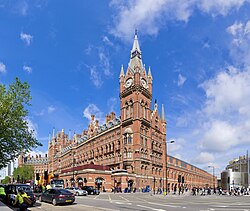Introduction
Victorian architecture encompasses a wide range of architectural revival styles that emerged during the reign of Queen Victoria (1837-1901) in Britain. It wasn't a single, unified style, but rather a reflection of the eclectic tastes and technological advancements of the era.
Key Characteristics
- Ornamentation: A defining feature. Buildings were adorned with elaborate details like fretwork, stained glass, bracketed cornices, and decorative moldings.
- Material Variety: Brick, stone, wood, and cast iron were commonly used, often combined in a single structure.
- Rooflines: Steeply pitched roofs with slate or tile coverings were popular. Some styles, like Second Empire, featured distinctive mansard roofs with dormer windows.
- Asymmetry: As opposed to the symmetry of earlier Georgian style, Victorian buildings often embraced asymmetry in their floor plans and facades.
- Color: While white and beige were common earlier, the Victorians introduced a wider color palette with earth tones, pastels, and jewel tones.
Sub-styles of Victorian Architecture
Victorian architecture is an umbrella term for several revival styles. Here are some prominent ones:
- Gothic Revival: Inspired by medieval Gothic architecture, featuring pointed arches, stained glass windows, and decorative bargeboards (see Figure 1).
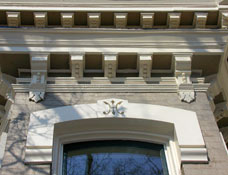

- Italianate: Drawing influence from Italian Renaissance buildings, these structures had symmetrical facades, low-pitched roofs with wide eaves, and round-headed windows (see Figure 2).
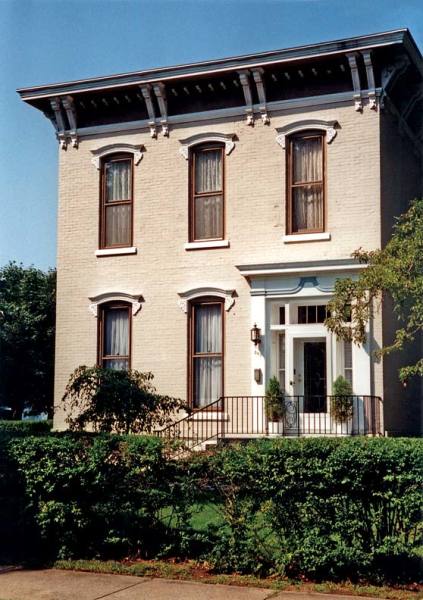
- Second Empire: Characterized by mansard roofs with dormer windows, bracketed cornices, and quoins (decorative stone blocks at building corners) (see Figure 3).
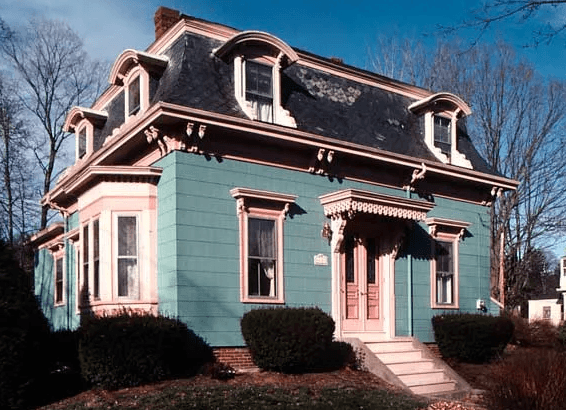
- Queen Anne: Known for their asymmetry, decorative towers, wraparound porches, and use of patterned shingles (see Figure 4).


Technological Advancements
The Victorian era saw advancements in iron and steel production, allowing for the creation of more ornate details and larger windows.
Technical Aspects of Victorian Architecture
Building upon the introductory notes, let's delve deeper into some technical aspects of Victorian architecture relevant for B.Arch students:
1. Materials and Construction:
- Brick: Mass-produced brick became a dominant material. Common laying patterns included English bond, Flemish bond, and herringbone.
- Stone: Used for foundations, structural elements, and decorative features. Popular choices were sandstone, granite, and limestone.
- Cast Iron: A revolutionary material allowing for intricate details, columns, lintels, and decorative moldings.
- Wrought Iron: Used for railings, decorative elements, and roof trusses.
- Timber: Essential for framing, floors, and decorative elements. Advancements in sawmilling allowed for mass production of moldings and fretwork.
- Glass: Large-scale glass production enabled expansive windows and skylights, contributing to brighter interiors. Stained glass became a hallmark of Gothic Revival buildings.
2. Structural Systems:
- Load-bearing Walls: Brick and stone walls primarily carried the weight of the building. Timber floor joists spanned between walls.
- Cast Iron Columns: Introduced in the mid-Victorian era, allowing for larger, open floor plans and more creative use of space.
- Steel Trusses: Late Victorian developments with steel trusses enabled vast, column-free spaces, often seen in railway stations and public buildings.
3. Architectural Details:
- Polychromy: The use of multiple colors on a building's exterior, often brick with contrasting stone details or painted elements.
- Bargeboards: Ornate wooden boards decorating the gables of buildings, especially prevalent in Gothic Revival.
- Cornices: Horizontal moldings projecting from the top of walls, often bracketed in Victorian styles.
- Quoins: Decorative stone blocks highlighting corners and openings.
- Finials: Ornamental elements placed at the top of roofs, towers, or gables.
- Soffits: The underside of an architectural element, often elaborately decorated in Victorian architecture.
4. Technological Influences:
- Steam Power: Enabled mass production of building materials like bricks and timber, leading to faster construction and more standardized elements.
- Plate Glass: Advances in glass production allowed for larger windows, improving natural light and creating a more open feel in buildings.
- Cast Ironwork: Revolutionized ornamentation and structural support, allowing for intricate details and innovative designs.
The Arts and Crafts Movement: A Reaction to Victorian Excess
The Arts and Crafts movement, flourishing in the late 19th and early 20th centuries, emerged as a direct critique of the mass-produced, often ostentatious nature of Victorian architecture. Here's a breakdown of its impact:
A Rejection of Mass Production:
- Victorian architecture heavily relied on factory-made components, leading to a sense of uniformity and a decline in craftsmanship.
- The Arts and Crafts movement championed a return to traditional building methods, emphasizing the value of skilled artisans and bespoke details.
- Architects like Philip Webb and Charles Rennie Mackintosh focused on natural materials, exposed beams, and handcrafted elements, injecting individuality into buildings.
A Return to Simplicity:
- Victorian buildings were often adorned with elaborate ornamentation and a focus on visual opulence.
- The Arts and Crafts movement advocated for simplicity and functionality in design. Buildings prioritized clean lines, well-proportioned spaces, and a focus on the inherent beauty of natural materials.
- This shift reflected a desire for a more honest and purposeful approach to architecture, prioritizing human experience over visual ostentation.
Focus on Social Reform:
- The Arts and Crafts movement wasn't just about aesthetics; it carried a social message. The harsh working conditions of factory workers in Victorian times were a concern.
- By promoting traditional crafts and advocating for a return to skilled labor, the movement aimed to improve the lives of artisans and elevate their work to an art form.
Influence on Victorian Architecture:
- While the Arts and Crafts movement didn't completely replace Victorian styles, it had a significant influence.
- Some architects, like Edwin Lutyens, blended elements of both movements, creating a more restrained and handcrafted version of Victorian architecture.
- The emphasis on natural materials, traditional construction methods, and functional design resonated with architects who sought to elevate the quality and integrity of their buildings.
Lasting Legacy:
- The Arts and Crafts movement laid the groundwork for the rise of modern architecture in the 20th century, with its focus on functionality and clean lines.
- The movement's emphasis on handcrafted details and the value of skilled labor continues to inspire architects and designers who appreciate the beauty and integrity of well-made buildings.
In conclusion, the Arts and Crafts movement served as a corrective force to the excesses of Victorian architecture. By emphasizing traditional craftsmanship, simplicity, and social reform, it left a lasting impact on architectural design and continues to influence architects who value artistry and human connection in the built environment.
Victorian era paintings
Victorian era paintings (1837-1901) were a product of their times, reflecting both the booming industrial revolution and a yearning for beauty and tradition.expand_more Here's a breakdown for architecture students:
Materials:
- Canvases: Linen was the most popular choice, offering a smooth, long-lasting surface.
- Paints: Oil paints were dominant, known for their rich colors and ability to create detailed layers. Pigments were derived from minerals, plants, and even insects, with some rarer colors being very expensive.
- Easel: Wooden easels with adjustable heights allowed for precise positioning of the canvas.
- Brushes: Made from natural hair like hog bristle for bold strokes and finer hairs like sable for delicate details.
Techniques:
- Gesso: The canvas was first primed with gesso, a white chalky mixture that provided a smooth base for the paint.
- Underpainting: A monochrome base layer was often applied to establish light and shadow values.
- Layering: Victorians excelled in creating depth through layering translucent oil paints. Glazes, thin washes of color, were used to create subtle effects.
- Impasto: Raised, textured brushstrokes were used to emphasize details like clothing or flowers.
Relevance to Architecture:
- Understanding materials: Knowing how Victorians achieved certain effects with limited materials can inspire architects to explore innovative uses of contemporary materials.
- Light and shadow: The Victorian mastery of light and shadow through layering techniques can inform architects' design decisions regarding natural and artificial lighting within a space.
- Balance and composition: Victorian paintings often adhered to a sense of balance and composed storytelling. This understanding of composition can be applied to architectural design, creating harmonious and visually engaging structures.
Famous Painters:
The Victorian era boasted a wealth of artistic talent. Here are some of the most famous Victorian painters, each with their own distinct style:
Pre-Raphaelites:
- Dante Gabriel Rossetti: A founding member of the Pre-Raphaelite Brotherhood, known for his intensely detailed and symbolic paintings with literary themes (e.g., "The Blessed Damozel").
- William Holman Hunt: Another Pre-Raphaelite leader, known for his focus on religious themes and meticulous attention to detail (e.g., "The Light of the World").
- John Everett Millais: A versatile artist who started with the Pre-Raphaelites and later adopted a more academic style. Famous for his dramatic and emotionally charged paintings (e.g., "Ophelia").
Aesthetes and Classicists:
- Edward Burne-Jones: A leading figure in the Aesthetic Movement, known for his dreamlike and allegorical paintings often inspired by mythology (e.g., "Pygmalion and Galatea").
- Frederic Leighton: A master of historical paintings, especially those depicting scenes from Ancient Greece and Rome, with a focus on beauty and idealism (e.g., "Flaming June").
- Lawrence Alma-Tadema: Renowned for his incredibly detailed and realistic reconstructions of life in Ancient Rome and Greece (e.g., "The Roses of Heliogabalus").
Others:
- John Singer Sargent: A prominent portrait artist who captured the elegance and grandeur of Victorian society (e.g., "Lady Agnew of Lochnaw").
- George Frederic Watts: A prolific painter known for his allegorical and symbolist works, often addressing social and political issues (e.g., "Hope").
- Evelyn De Morgan: A female artist who challenged societal norms through her allegorical and mythological paintings with strong female characters (e.g., "The Co-Givers").
References
- Victorian Architecture: An Overview: https://www.britannica.com/art/Victorian-architecture from Britannica
- What Is Victorian Architecture?: https://www.thespruce.com/victorian-architecture-4769162 from The Spruce
- Victorian Architecture | HGTV: https://www.hgtv.com/design/decorating/design-101/victorian-architecture from HGTV
Additional Notes
- Victorian architecture can be further explored by region, as specific styles were more prominent in certain areas.
- Consider incorporating pictures of famous Victorian buildings like the Houses of Parliament in London or the Painted Ladies in San Francisco for a more engaging presentation.
Leave a comment
Your email address will not be published. Email is optional. Required fields are marked *



